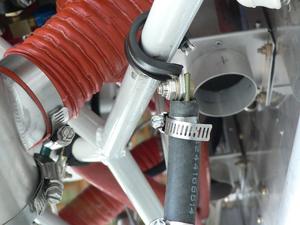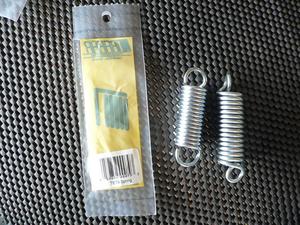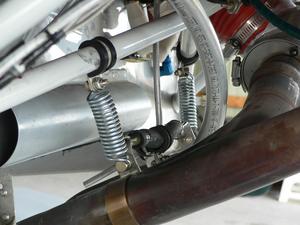Flight 23 Report
- Details
- Written by Kevin Horton
- Hits: 3049
Inter-flight activities:
- Reseated connector on back of Narco 122D, which restored it to serviceability.
Events:
- GNS 430 GPS flight test, in accordance with guidelines in FAA AC 20-138A. GPS passed all ground and flight tests.
New Snags:
- Rattling sound on final for last landing. Sounded like it came from the engine area. Need to pull the cowlings and inspect engine and airframe.
Existing Snags:
- RPM 2650 with prop control full forward. Need to slightly adjust the stop at the governor.
- SD-8 Alternator does not seem to be working. Will defer troubleshooting until engine break-in is completed, as it would be useful to check for AC output from alternator during an engine ground run.
- Small amount of right rudder pedal force needed in cruise. Need to add a wedge on the left side of the rudder trailing edge.
- Pitch trim speed of movement is slow during a touch and go. Need to try it with the pitch trim speed governor removed.
Flight 22 Report
- Details
- Written by Kevin Horton
- Hits: 3334
Inter-flight activities:
- Checked internal oil leakage in the prop control circuit in accordance with Lycoming Service Instruction 1462A. Leakage was within the acceptable range.
- Adjusted prop governor control cable at prop governor to move the cable sheaf closer to the governor control air. This increased the clearance between the prop control lever and the forward stop in the cockpit.
- Added additional "fuzzy" Velcro strips under the aft canopy skirt to stop it from buzzing against the fuselage skin at high speed.
- Replaced broken exhaust system hangar clamps. Changed flexible hangar links to springs.
- Reinstalled rubber sealing strip between left upper wing intersection fairing and fuselage.
Events:
- Cruise performance flight testing at 7500 ft. Covered 65 KIAS to 160 KIAS. The air was smooth, but there appeared to be occasional up and down drafts, which added noise to the data.
- Checked max rpm with prop control full forward. It is 2650 during the first take-off, and slowly decreases to 2600 to 2610 as the engine warms up. This 40 - 50 rpm drop appears to be normal, based on discussions with a local Pitts Special pilot who has three aircraft with MT aerobatic props. It seems that the prop governor is working correctly.
- Check for canopy buzz at VNE. No buzz!!
Data Analysis:
- Initial data analysis confirms results from earlier flights that showed cruise speed is slower than it was with the Hartzell prop. Initial very rough estimate is 7 to 10 kt slower at the same power. Need to repeat these tests with better air quality.
New Snags:
- Narco 122D stopped working during the flight. It seems to no longer be supplied with power.
Existing Snags:
- SD-8 Alternator does not seem to be working. Will defer troubleshooting until engine break-in is completed, as it would be useful to check for AC output from alternator during an engine ground run.
- Small amount of right rudder pedal force needed in cruise. Need to add a wedge on the left side of the rudder trailing edge.
- Pitch trim speed of movement is slow during a touch and go.
- Data from EIS 4000 engine monitor is no longer being recorded.
Flight 21 Report
- Details
- Written by Kevin Horton
- Hits: 3199
Inter-flight activities:
- Added "fuzzy" Velcro strips under the left side of the aft canopy skirt to stop it from buzzing against the fuselage skin at high speed.
Events:
- Engine break-in.
- Checked for canopy skirt buzz at high speed. The buzz is still present :(
New Snags:
- Aperiodic banging noise started while in cruise. The airspeed was reduced, and the mission was aborted. Found rubber sealing strip at left wing to fuselage intersection fairing loose.
Existing Snags:
- RPM still low in level flight with max rpm selected.
- SD-8 Alternator does not seem to be working. Will defer troubleshooting until engine break-in is completed, as it would be useful to check for AC output from alternator during an engine ground run.
- Small amount of right rudder pedal force needed in cruise. Need to add a wedge on the left side of the rudder trailing edge.
- Pitch trim speed of movement is slow during a touch and go.
- Data from EIS 4000 engine monitor is no longer being recorded.
Exhaust Hangars
- Details
- Written by Kevin Horton
- Hits: 3887
 I also noted when I had the cowlings off that both exhaust hangar Adel clamps had broken at the engine mount. I had one clamp break a few flights ago, and now there were two more. The problem is that the exhaust moves with the engine, but the engine mount is fixed. My exhaust system is an early RV-8 system, with very short rubber pieces that attempt to allow some movement between the exhaust pipes and the engine mount. There is only about 3 inches between the bolt on the Adel clamp and the bolt at the exhaust system. The metal tubes that the rubber hoese pieces are clamped too take up about two of those three inches, so there is only about one inche of rubber tube that can flex. Not enough.
I also noted when I had the cowlings off that both exhaust hangar Adel clamps had broken at the engine mount. I had one clamp break a few flights ago, and now there were two more. The problem is that the exhaust moves with the engine, but the engine mount is fixed. My exhaust system is an early RV-8 system, with very short rubber pieces that attempt to allow some movement between the exhaust pipes and the engine mount. There is only about 3 inches between the bolt on the Adel clamp and the bolt at the exhaust system. The metal tubes that the rubber hoese pieces are clamped too take up about two of those three inches, so there is only about one inche of rubber tube that can flex. Not enough.
Apparently this design has had a high failure rate, and the currently shipping exhaust systems have long supports that attach to the bolts at the back of the oil sump. I studied that as a possible mod, but I’ve got a heat muff that is in the way.
 I looked at one of the Mooney’s in the same hangar. The back end of its exhaust system is supported from the firewall area, hanging from springs.
I looked at one of the Mooney’s in the same hangar. The back end of its exhaust system is supported from the firewall area, hanging from springs.
I went to a local hardware store that had a large selection of springs, and picked up a couple to experiment with. I stretched the springs to make some space between the coils, and I squeezed the loops at the end to reduce the diameter, and twisted the springs to get 90 degrees between the loops on each end. The spring as I bought it is on the left, and the modified one on the right.
Prop Governor
- Details
- Written by Kevin Horton
- Hits: 4918
I zipped out to the airport today early, arriving around 7:30 AM, wanting to get a quick flight off before a cold front arrived. There was already about five knots of crosswind, which was a nice step up from yesterday’s essentially calm winds. I did a bit of cruise performance testing, then an aperiodic banging sound started. The sound didn’t change when I selected each ignition system OFF - ON, nor did the engine instruments show any anomaly. But, banging sounds are not what you want to hear, so I slowed down and headed back to the airport. 30 minutes airborne.
After I got back to the hangar, I took a close look over the whole aircraft, and found that the rubber wing root fairing seal had come loose above the left wing root.
I’ve been watching an anomaly with the prop governor. In the handful of flights I did after the prop change, but before the car accident, I noted that the max rpm would decrease about 100 rpm as the engine got up to temperature. The rpm would be close to 2700 rpm for the first take-off, but it would slowly decrease about 100 rpm over the first 10 minutes of the flight. I contacted Aero Technologies tech support, and they suggested I check for internal leaks in the prop governor oil system as described in Lycoming Service Instruction 1462A. SI 1462A calls for the prop governor to be removed, and a special cover plate to be installed in its place. The cover plate has fittings allowing the oil passages and external oil line going to the prop to be pressurized with an air compressor, using a differential compression tester. The input pressure is set to 40 psi, and the pressure downstream of the orifice in the differential compression tester must reed between 6 and 35 psi (this pressure is a measure of the amount of leakage in the system - lower pressure means more air flowing through the orifice, which implies greater leakage downstream).
I didn’t want to remove the prop governor yet, as it is a big job. So, I disconnected the oil line at the prop governor, and did the test from there. That allowed me to check for leakage downstream of the oil line - i.e. up at the nose of the crankshaft. With the warm, I got a reading of 12 to 15 psi, which is in the acceptable range. That is excellent news, because a problem in that area would require the engine to go back to the overhaul shop.
I discussed my prop governor issues with Andrew, a local Pitts Special pilot today. His three aircraft have MT aerobatic props too, but his prop governors are not the same as mine. He sees about a 50 rpm decrease in max rpm as the engines comes up to temperature. He suggested that perhaps I should defer digging too deep until I had switched over to my normal oil - at the moment I’m running Phillips Type M 20W-50 mineral oil. Andrew thought that perhaps the symptoms might change when I changed oil types.
I noted during this flight that the max rpm was not directly related to oil temperature as I had originally thought. I can vary the oil temperatue by opening and closing a door in front of my oil cooler. I noted max rpm vs oil temperature as the engine came up to temperature in the early part of the flight, then later on I varied the oil temperature and compared max rpm to the earlier values. I noted that even at the same oil temperature, the max rpm was lower later in the flight. This suggests that my earlier theory of excessive internal oil leakage that allowed greater leakage as the oil thins out might not be the winner.
I checked the travel of my prop control, and noted that the prop control in the cockpit was very close to its stop at the throttle quadrant when the control arm on the engine hit the max rpm stop. I wondered if somehow differential expansion of the prop control cable and its sheaf as things warmed up ahead of the firewall might possibly cause the prop control to hit the stop the cockpit before it hits the stop at the prop governor. I adjusted the cable at the prop governor to give a bit more margin to the stop in the cockpit. We’ll see on the next flight if that makes any difference.
Flight 20 Report
- Details
- Written by Kevin Horton
- Hits: 3220
Inter-flight activities:
- Completed annual inspection.
- Adjusted pitch trim governor to highest speed.
- Shipped EFIS to Dynon for service, and reinstalled it.
- Removed turn and bank and had it repaired. Reinstalled it.
Events:
- Slow flight.
- Stalls.
- Avionics functional check.
- Two touch and go landings.
New Snags:
- None.
Existing Snags:
- RPM still low in level flight with max rpm selected.
- SD-8 Alternator does not seem to be working. Will defer troubleshooting until engine break-in is completed, as it would be useful to check for AC output from alternator during an engine ground run.
- Small amount of right rudder pedal force needed in cruise. Need to add a wedge on the left side of the rudder trailing edge.

